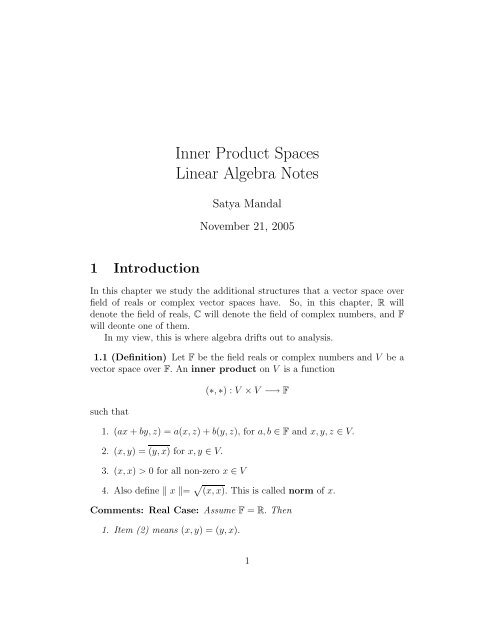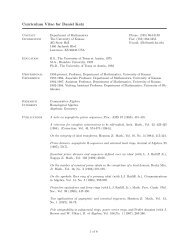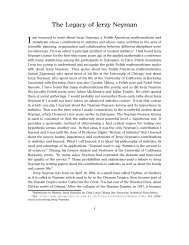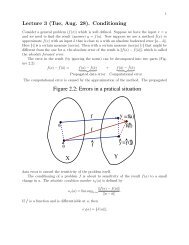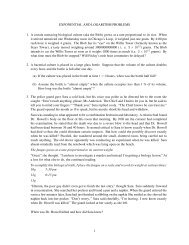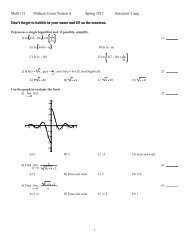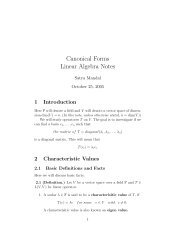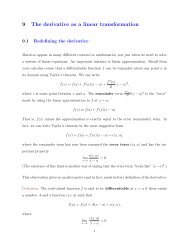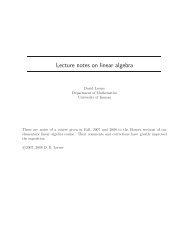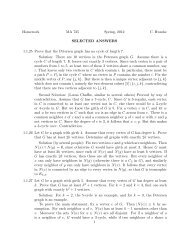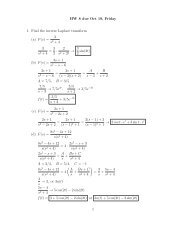Inner Product Spaces Linear Algebra Notes
Inner Product Spaces Linear Algebra Notes
Inner Product Spaces Linear Algebra Notes
Create successful ePaper yourself
Turn your PDF publications into a flip-book with our unique Google optimized e-Paper software.
1 Introduction<br />
<strong>Inner</strong> <strong>Product</strong> <strong>Spaces</strong><br />
<strong>Linear</strong> <strong>Algebra</strong> <strong>Notes</strong><br />
Satya Mandal<br />
November 21, 2005<br />
In this chapter we study the additional structures that a vector space over<br />
field of reals or complex vector spaces have. So, in this chapter, R will<br />
denote the field of reals, C will denote the field of complex numbers, and F<br />
will deonte one of them.<br />
In my view, this is where algebra drifts out to analysis.<br />
1.1 (Definition) Let F be the field reals or complex numbers and V be a<br />
vector space over F. An inner product on V is a function<br />
such that<br />
(∗, ∗) : V × V −→ F<br />
1. (ax + by, z) = a(x, z) + b(y, z), for a, b ∈ F and x, y, z ∈ V.<br />
2. (x, y) = (y, x) for x, y ∈ V.<br />
3. (x, x) > 0 for all non-zero x ∈ V<br />
4. Also define x = (x, x). This is called norm of x.<br />
Comments: Real Case: Assume F = R. Then<br />
1. Item (2) means (x, y) = (y, x).<br />
1
2. Also (1 and 2) means that the inner product is bilinear.<br />
Comments: Complex Case: Assume F = C. Then<br />
1. Items (1 and 2) means that the (x, cy + dz) = c(x, y) + c(x, z).<br />
1.2 (Example) On R n we have the standard inner product defined by<br />
(x, y) = n<br />
i=1 xiyi, where x = (x1, . . . , xn) ∈ R n and y = (y1, . . . , yn) ∈ R n<br />
1.3 (Example) On C n we have the standard inner product defined by<br />
(x, y) = n<br />
i=1 xiyi, where x = (x1, . . . , xn) ∈ C n and y = (y1, . . . , yn) ∈ C n<br />
1.4 (Example) Let F = R<br />
(bij) ∈ V define inner product<br />
OR C and V = Mn(F). For A = (aij), B =<br />
(A, B) = <br />
aijbij.<br />
Define conjugate transpose B ∗ = (B) t . Then<br />
i,j<br />
(A, B) = trace(B ∗ A)<br />
1.5 (Example: Integration ) Let F = R OR C and V be the vector<br />
space of all F−valued continuous functions on [0, 1]. For f, g ∈ V define<br />
1<br />
(f, g) = fgdt.<br />
This is an inner product on V. In some distant future this will be called L 2<br />
inner product space. This can be done in any ”space” where you have an<br />
idea of integration and it will come under Measure Theory.<br />
1.6 (Matrix of <strong>Inner</strong> <strong>Product</strong>) Let F = R OR C. Suppose V is a<br />
vector space over F with an inner product. Let e1, . . . , en be a basis of V. Let<br />
pi,j = (ei, ej) and P = (pij) ∈ Mn(F). Then for v = x1e1 + · · · + xnen ∈ V<br />
and W = y1e1 + · · · + ynen ∈ V we have<br />
⎛ ⎞<br />
(v, w) = xiyjpij = (x1, . . . , xn)P<br />
2<br />
0<br />
⎜<br />
⎝<br />
y1<br />
y2<br />
. . .<br />
yn<br />
⎟<br />
⎠
1. This matrix P is called the matrix of the inner product with respect<br />
to the basis e1, . . . , en.<br />
2. (Definition.) A matrix B is called hermitian if B = B ∗ .<br />
3. So, matrix P in (1) is a hermitian matrix.<br />
4. Since (v, v) > 0, for all non-zero v ∈ V, we have<br />
XP X t > 0 for all non − zero X ∈ F n .<br />
5. It also follows that P is non-singular. (Otherwise XP = 0 for some<br />
non-zero X.)<br />
6. Conversely, if P is a n × n hermitian matrix satisfying such that<br />
XP X t > 0 for all X ∈ F n then<br />
(X, Y ) = XP Y t<br />
defines an inner product on F n .<br />
3<br />
for X ∈ F n .
2 <strong>Inner</strong> <strong>Product</strong> <strong>Spaces</strong><br />
We will do calculus of inner produce.<br />
2.1 (Definition) Let F = R OR C. A vector space V over F with an<br />
inner product (∗, ∗) is said to an inner product space.<br />
1. An inner product space V over R is also called a Euclidean space.<br />
2. An inner product space V over C is also called a unitary space.<br />
2.2 (Basic Facts) Let F = R OR C and V be an inner product over F.<br />
For v, w ∈ V and c ∈ F we have<br />
1. cv =| c | v ,<br />
2. v > 0 if v = 0,<br />
3. | (v, w) | ≤ v w , Equility holds if and only if w = (w,v)<br />
v 2 v.<br />
(It is called the Cauchy-Swartz inequality.)<br />
4. v+w ≤ v + w . (It is called the triangular inequality.)<br />
Proof. Part 1 and 2 is obvious from the definition. To prove the Part (3),<br />
we can assume that v = 0. Write<br />
Then (z, v) = 0 and<br />
z = w −<br />
(w, v)<br />
v.<br />
v 2 0 ≤ z 2 (w, v)<br />
v)<br />
= (z, w− v) = (z, w) = (w−(w,<br />
v 2 v 2 v, w) = w 2 (w, v)(v, w)<br />
−<br />
v 2 .<br />
This establishes (3). We will use Part 3 to prove Part 4, as follows:<br />
v + w 2 = v 2 +(v, w) + (w, v)+ w 2 = v 2 +2Re[(v, w)]+ w 2 ≤<br />
v 2 +2 | (v, w) | + w 2 ≤ v 2 +2 v w + w 2 = ( v + w ) 2 .<br />
This establishes Part 4.<br />
4
2.3 (Application of Cauchy-Schwartz inequality) Application of (3)<br />
of Facts 2.2 gives the following:<br />
1. Example 1.2 gives<br />
for x,yi ∈ R.<br />
2. Example 1.3, gives<br />
for x,yi ∈ C.<br />
|<br />
|<br />
i=1<br />
3. Example 1.4, gives<br />
for A, B ∈ Mn(C).<br />
4. Example 1.5, gives<br />
1<br />
|<br />
0<br />
n<br />
n<br />
xiyi |≤ (<br />
i=1<br />
n<br />
n<br />
xiyi |≤ (<br />
i=1<br />
i=1<br />
x 2 i ) 1/2 (<br />
| xi | 2 ) 1/2 (<br />
n<br />
i=1<br />
n<br />
i=1<br />
y 2 i ) 1/2<br />
| yi | 2 ) 1/2<br />
| trace(AB ∗ ) |≤ trace(AA ∗ ) 1/2 trace(BB ∗ ) 1/2<br />
1<br />
f(t)g(t)dt |≤ ( | f(t) |<br />
0<br />
2 dt) 1/2 1<br />
( | g(t) |<br />
0<br />
2 dt) 1/2<br />
for any two continuous C−valued functions f, g on [0, 1].<br />
5
2.1 Orthogonality<br />
2.4 (Definition) Let F be R or C. Let V be an inner product space over<br />
F.<br />
1. Supppose v, w ∈ V. We say that v and w are mutually orthogonal<br />
if the inner product (v, w) = 0 (OR equivalently if (w, v) = 0. We use<br />
variations of the expression ”mutually orthogonal” and sometime we<br />
do not mention the word ”mutually”.)<br />
2. For v, w ∈ V we write v ⊥ w to mean v and w are mutually orthogonal.<br />
3. A subset S ⊆ V is said to be an orthogonal set if<br />
v ⊥ w for all v, w ∈ S, v = w.<br />
4. An othrhogonal set S is said to be an orthnormal set if<br />
v = 1 for all v ∈ S.<br />
5. (Comment) Note the zero vector is otrhogonal to all elements of V.<br />
6. (Comment) Geometrically, v ⊥ w means v is perpendicular to w.<br />
7. (Example) Let V = R n or V = C n . Then the standard basis E =<br />
{e1, . . . , en} is an orthonormal set.<br />
8. (Example) In R 2 or C 2 , we have the ordered pairs v = (x, y) and<br />
w = (y, −x) are oththogonal. (Caution: Notation (x, y) here.)<br />
2.5 (Example) Cosider the example 1.5 over R. Here V is the inner product<br />
space of all real valued continuous functions on [0, 1]. Let<br />
Then<br />
is an orthonormal set.<br />
fn(t) = √ 2 cos(2πnt) gn(t) = √ 2 sin(2πnt)<br />
{1, f1, g1, f2, g2, . . .}<br />
6
Now consider the inner product space W in the same example 1.5 over<br />
C. Let<br />
hn = fn + ign<br />
√ 2 = exp(2πint).<br />
Then<br />
is an orthonormal set<br />
{hn : n = 0, 1, −1, 2, −2, . . . , , . . .}<br />
2.6 (Theorem) Let F = R or F = C and let V be an inner product space<br />
over F. Let S be an orthogonal set of non-zero vectors. Then S is linearly<br />
independent. (Therefore, cardinality(S) ≤ dim V. )<br />
Proof. Let v1, v2, . . . , vn ∈ S and<br />
c1v1 + c2v2 + · · · + cnvn = 0<br />
where ci ∈ F. We will prove ci = 0. For example, apply inner product (∗, v1)<br />
to the above equation. We get:<br />
c1(v1, v1) + c2(v2, v1) + · · · + cn(vn, v1) = (0, v1) = 0.<br />
Since (v1, v1) = 0 and (v2, v1) = (v3, v1) = · · · = (vn, v1) = 0, we get c1 = 0.<br />
Similarly, ci = 0 for all i = 1, . . . , n.<br />
2.7 (Theorem) Let F = R or F = C and let V be an inner product space<br />
over F. Assume {e1, e2, . . . , er} is a set of non-zero orthogonal vectors. Let<br />
v ∈ V and<br />
v = c1e1 + c2e2 + · · · + crer<br />
where ci ∈ F. Then<br />
for i = 1, . . . , r.<br />
ci =<br />
(v, ei)<br />
ei 2<br />
Proof. For example, apply inner product (∗, e1) to the above and get<br />
(v, e1) = c1(e1, e1) = c1 e1 2<br />
So, c1 is as asserted and, similarly, so is ci for all i.<br />
7
2.8 (Theorem) Let F = R or F = C and let V be an inner product space<br />
over F. Let v1, v2, . . . , vr be a set of linearly independent set. Then we can<br />
construct elements e1, e2, . . . , er ∈ V such that<br />
1. {e1, e2, . . . , er} is an orthonormal set,<br />
2. ek ∈ Span({v1, . . . , vk})<br />
Proof. The proof is known as Gram-Schmidt orthogonalization<br />
process. Note v1 = 0. First, let<br />
Then e1 = 1. Now lat<br />
e1 = v1<br />
v1 .<br />
e2 = v2 − (v2, e1)e1<br />
v2 − (v2, e1)e1 .<br />
Note that the denominator is non-zero, e1 ⊥ e2 and e2 = 1. Now we use<br />
the induction. Suppose we already constructed e1, . . . , ek−1 that satisfies (1)<br />
and (2) and k ≤ r. Let<br />
ek = vk − k−1 i=1 (vk, ei)ei<br />
vk − k−1 i=1 (vk, ei)ei .<br />
Note that the denominator is non-zero, ek = 1. and ek ⊥ ei for i =<br />
1, . . . , k − 1. From construction, we also have<br />
So, the proof is complete.<br />
Span({v1, . . . , vk}) = Span({e1, . . . , ek}).<br />
2.9 (Corollary) Let F = R or F = C and let V be a finite dimensional<br />
inner product space over F. Then V has an orthonormal basis.<br />
Proof. The proof is immediate from the above theorem 2.8.<br />
Examples. Read examples 12 and 13, page 282, for some numerical computations.<br />
8
2.10 (Definition) Let F = R or F = C and let V be a inner product space<br />
over F. Let W be a subspace of V and v ∈ V. An element w0 ∈ W is said to<br />
be a best approximation to v or nearest to v in W , if<br />
v − w0 ≤ v − w for all w ∈ W.<br />
(Try to think what it means in R 2 or C n when W is line or a plane through<br />
the origin.)<br />
Remark. I like the expression ”nearest” and the textbook uses ”best approximation”.<br />
I will try to be consistent to the textbook.<br />
2.11 (Theorem) Let F = R or F = C and let V be a inner product space<br />
over F. Let W be a subspace of V and v ∈ V. Then<br />
1. An element w0 ∈ W is best approximation to v if and only if (v −w0) ⊥<br />
w for all w ∈ W.<br />
2. A best approximation w0 ∈ W to v, if exists, is unique.<br />
3. Suppose W is finite dimensional and e1, e2, . . . , en is an orthonormal<br />
basis of W. Then<br />
n<br />
w0 = (v, ek)ek<br />
k=1<br />
is the best approximation to v in W. (The textbook mixes up orthogonal<br />
and orthonormal and have a condition the looks complex. We assume<br />
orthonormal and so ei = 1)<br />
Proof. To prove (1) let w0 ∈ W be such that (v − w0) ⊥ w for all w ∈ W.<br />
Then, since w − w0 ∈ W, we have<br />
v−w 2 = (v−w0)+(w0−w) 2 = (v−w0) 2 + (w0−w) 2 ≥ (v−w0) 2 .<br />
Therefore, w0 is nearest to v. Conversely, assume that w0 ∈ W is nearest to<br />
v. We will prove that the inner product (v − w0, w) = 0 for all w ∈ W. For<br />
convenience, we write v0 = v − w0. So, we have<br />
v0 2 ≤ v − w 2<br />
9<br />
Eqn − I
for all w ∈ W. Write v − w = v − w0 + (w0 − w) = v0 + (w0 − w). Since<br />
any element in w van be written as w0 − w for some w ∈ W, Eqn-I can be<br />
rewritten as<br />
v0 2 ≤ v0 + w 2<br />
for all w ∈ W. So, we have<br />
and hence<br />
v0 2 ≤ v0 + w 2 = v0 2 +2Re[(v0, w)]+ w 2<br />
0 ≤ 2Re[(v0, w)]+ w 2<br />
for all w ∈ W.<br />
Fix w ∈ W with w = w0 and write<br />
τ = − (v0, w0 − w)<br />
w0 − w 2 (w0 − w).<br />
Eqn − II<br />
Since, τ ∈ W, we can substitute τ for w in Eqn-II and get<br />
0 ≤ − | (v0, w0 − w) | 2<br />
w0 − w 2 .<br />
Therefore (v0, w0 − w) = 0 for all w ∈ W with w0 − w = 0. Again, since any<br />
non-zero element in W can be written as w0 − w, it follows that (v0, w) = 0<br />
for all w ∈ W. So the proof of (1) is complete.<br />
To prove Part 2 , let w0, w1 be nearest to v. Then, by orthogonality (1) ,<br />
we have<br />
w0 − w1 2 = (w0 − w1, w0 − w1) = (w0 − w1, [w0 − v] + [v − w1]) = 0.<br />
So, Part 2 is established.<br />
Let w0 be given as in Part 3. Now, to prove Part 3, we will prove (w0−v) ⊥<br />
ei for i = 1, . . . , n. So, for example,<br />
(w0 − v, e1) = (w0, e1) − (v, e1) = (v, e1)(e1, e1) − (v, e1) = 0.<br />
So, Part 3 is established.<br />
10
2.12 (Definition) Let F = R or F = C and let V be an inner product space<br />
over F. Let S be a subset of V. The otrhogonal complement S ⊥ of S is<br />
the set of all elements in V that are orthogonal to each element of S. So,<br />
It is easy to check that<br />
1. S ⊥ is a subspace of V.<br />
2. {0} ⊥ = V and<br />
3. V ⊥ = {0}.<br />
S ⊥ = {v ∈ V : v ⊥ w for all w ∈ S}.<br />
2.13 (Definition and Facts) Let F = R or F = C and let V be an inner<br />
product space over F. Let W be a subspace of V. Suppose v ∈ V, we say that<br />
w ∈ W is the orthogonal projection of v to W, if w is nearest to v.<br />
1. There is no guarantee that orthogonal projection exists. But by Part<br />
2 of theorem 2.11, when it exists, orthogonal projection is unique.<br />
2. Also, if dim(W ) is finite, then by Part 3 of theorem 2.11, orthogonal<br />
projection always exists.<br />
3. Assume dim(W ) is finite. Define the map<br />
πW : V → V<br />
where π(v) is the orthogonal projection of v in W. The map πW is a<br />
linear operator and is called the orthogonal projection of V to W.<br />
Clearly, π 2 W = πW . So, πW is , indeed, a projection.<br />
4. For v ∈ V, let E(v) = v − πW (v). Then E is the othrogonal projection<br />
of V to W ⊥ . Proof. By definition of πW , we have, E(v) = v −πW (v) ∈<br />
W ⊥ . Now, given v ∈ V and w ∗ ∈ W ⊥ we have, (v − E(v), w ∗ ) =<br />
(πW (v), w ∗ ) = 0. So, by theorem 2.11, E is the projection to W ⊥ .<br />
Example. Read Example 14, page 286.<br />
11
2.14 (Theorem) Let F = R or F = C and let V be an inner product space<br />
over F. Let W be a finite dimensional subspace of V. Then πW is a projection<br />
and W ⊥ is the null space of πW . Therefore,<br />
Proof. Obvious.<br />
V = W ⊕ W ⊥ .<br />
2.15 (Theorem: Bessel’s inequality) Let F = R or F = C and let V be<br />
an inner product space over F. Suppose {v1, v2, . . . , vn} is an orthogonal set<br />
of non-zero vector. Then, for any element v ∈ V we have<br />
n<br />
k=1<br />
Also, the equality holds if and only if<br />
Proof. We write,<br />
and prove that<br />
n<br />
k=1<br />
| (v, vk) | 2<br />
vk 2 ≤ v 2 .<br />
v =<br />
n<br />
k=1<br />
(v, vk)<br />
vk.<br />
vk 2 ek = vk<br />
vk <br />
| (v, ek) | 2 ≤ v 2 .<br />
where {e1, e2, . . . , en} is an orthonormal set. Write W = Span({e1, e2, . . . , en}).<br />
By theorem 2.11,<br />
n<br />
w0 = (v, ek)ek<br />
k=1<br />
is nearest to v in W. So, (v − w0, w0) = 0. Therefore,<br />
So,<br />
v 2 = (v − w0) + w0 2 = (v − w0) 2 + w0 2 .<br />
v 2 ≥ w0 2 =<br />
12<br />
n<br />
| (v, ek) | 2 .<br />
k=1
Also note that the equality holds if and only if (v − w0) 2 = 0 if and only<br />
if v = w0. So, the proof is complete.<br />
If we apply Bessel’s inequality 2.15 to te example 2.5 we get the following<br />
inequality.<br />
2.16 (Theorem: Application of Bessel’s inequality) For and C−valued<br />
continuous funtion f on [0, 1] we have<br />
n<br />
k=−n<br />
1<br />
| f(t)exp(2πikt)dt | 2 1<br />
≤ | f(t) | 2 dt.<br />
0<br />
Homework: Exercise 1-7, 9, 11 from page 288-289. These are popular<br />
problems fro Quals.<br />
13<br />
0
3 <strong>Linear</strong> Functionals and Adjoints<br />
We start with some preliminary comments.<br />
3.1 (Comments and Theorems) Let F = R or F = C and let V be an<br />
inner product space over F.<br />
1. Given an element v ∈ V we can define a linear functional<br />
by fv(x) = (x, v).<br />
fv : V → F<br />
2. The association F (v) = fv. defines a natural linear map<br />
F : V → V ∗ .<br />
3. In fact, F is injective. Proof. Suppose fv = 0 Then (x, v) = 0 for all<br />
x ∈ V. so, (v, v) = 0 and hence v = 0.<br />
4. Now assume that V has finite dimension. Then the natural map F is<br />
an isomorphism.<br />
5. Again, assume V has finite dimension n and assume {e1, . . . , en} is an<br />
orthonormal basis. Let f ∈ V ∗ . Let<br />
n<br />
v = f(ei)ei.<br />
k=0<br />
Then f = F (v) = fv. That means,<br />
f(x) = (x, v) for all x ∈ V.<br />
Proof. We will only check f(e1) = (e1, v), which is obvious by orthonormality.<br />
6. Assume the same as in Part 5. Then the association<br />
n<br />
G(f) = f(ei)ei<br />
defines the inverse<br />
of F.<br />
k=0<br />
G : V ∗ → V<br />
14
7. (Remark.) The map F fails to be isomorphism if V is not finite<br />
dimensional. Following is an example that shows F is not on to.<br />
3.2 (Example) Let V be the vector space of polynomial over C. For f, g ∈<br />
V define inner product:<br />
1<br />
(f, g) = f(t)g(t)dt.<br />
0<br />
Note 1<br />
0 tj t k dt = 1<br />
j+k+1 . So, if f(X) = akX k and g(X) = bkX k we have<br />
(f, g) = <br />
j,k<br />
1<br />
j + k + 1 ajbk.<br />
Fix a complex number z ∈ C. By evaluation at z, we define the functional<br />
L : V → C as L(f) = f(z). for any f ∈ V. We claim that L is not in the<br />
image of tha map F : V → V ∗ . In other words, there is no polynomial g ∈ V<br />
such that<br />
1<br />
f(z) = L(f) = (f, g) = f(t)g(t)dt for all f ∈ V.<br />
0<br />
To prove this suppose there is such a g.<br />
Write h = X −z. Given f ∈ V, we have hf ∈ V and 0 = (hf)(z) = L(hf).<br />
So,<br />
1<br />
0 = L(hf) = (hf, g) = h(t)f(t)g(t)dt for all f ∈ V.<br />
By substituting f = (X − z)g we have<br />
1<br />
0 =<br />
Since h = 0 it follows g = 0. But L = 0.<br />
0<br />
0<br />
| h(t) | 2 | g(t) | 2 dt.<br />
15
3.1 Adjoint Operatior<br />
3.3 (Theorem) Let F = R or F = C and let V be an finite dimensional<br />
inner product space over F. Suppose T ∈ L(V, V ) is a linear operator. Then,<br />
there is a unique linear operator<br />
such that<br />
T ∗ : V → V<br />
(T (v), w) = (v, T ∗ (w)) for all v, w ∈ V.<br />
Definition. This operator T ∗ is called the Adjoint of T.<br />
Proof. Fix and element w ∈ V. Let Γ : V → F, be defined by the diagram:<br />
V<br />
T <br />
V<br />
<br />
<br />
(∗,w)<br />
Γ <br />
<br />
F<br />
That means Γ(v) = (T (v), w) for all v ∈ V.<br />
By Part 2 of thorem 3.1, there is an unique element w ′ such that<br />
That means<br />
Γ(v) = (v, w ′ ) for all v ∈ V.<br />
(T (v), w) = (v, w ′ ) for all v ∈ V. (Eqn − I)<br />
Now, define T ∗ (w) = w ′ . It is easy to check that T ∗ is linear (use Eqn-I).<br />
Uniqueness also follows from Eqn-I.<br />
3.4 (Theorem) Let F = R or F = C and let V be an finite dimensional<br />
inner product space over F. Suppose T ∈ L(V, V ) is a linear operator. Let<br />
e1, . . . , en be an orthomormal basis of V. Suppose T ∈ L(V, V ) be a linear<br />
operator of V.<br />
1. Write<br />
aij = (T (ej), ei) and A = (aij).<br />
Then A is the matrix of T with respect to e1, . . . , en.<br />
16<br />
,
2. With respect to e1, . . . , en, the matrix of the adjoint T ∗ is the conjugate<br />
transpose of the matrix A of T.<br />
Proof. To prove Part 1, we need to prove that<br />
⎛<br />
(T (e1), e1)<br />
⎜<br />
(T (e1), . . . , T (en)) = (e1, . . . , en) ⎜ (T (e1), e2)<br />
⎝ . . .<br />
(T (e2), e1)<br />
(T (e2), e2)<br />
. . .<br />
. . . (T (en), e1)<br />
. . . (T (en), e2)<br />
. . .<br />
(T (e1), en) (T (e2), en) . . . (T (en), en)<br />
This follows because, if T (e1) = λ1e1+λ2e2+· · ·+λnen, then λi = (T (e1), ei).<br />
So, the proof of Part 1 is complete.<br />
Now, by Part 1, them matrix of the adjoint T ∗ is<br />
B = ((T ∗ (ej), ei)) = ((ei, T ∗ (ej))) = ((T (ei), ej)) = A ∗ .<br />
This completes the proof of Part 2.<br />
3.5 (Theorem: Projection and Adjoint) Let F = R or F = C and let<br />
V be an finite dimensional inner product space over F. Let E ∈ L(V, V ) be<br />
an orthogonal projection. Then E = E ∗ .<br />
Proof. For any x, y ∈ V, we have<br />
(E(x), y) = (E(x), E(y)+[y−E(y)]) = (E(x), E(y)) because [y−E(y)] ⊥ W.<br />
Also<br />
(E(x), E(y)) = (x+[E(x)−x], E(y)) = (x, E(y)) because [x−E(x)] ⊥ W.<br />
Therefore<br />
Hence E = E ∗ .<br />
(E(x), y) = (x, E(y)) for allx, y ∈ V.<br />
3.6 (Remarks and Examples) let V = R and A ∈ Mn(R) be a symmetric<br />
matrix. Let T ∈ L(V, V ) be defined by A. Then T = T ∗ . Also note that<br />
matrix of T with respect to some other basis may not be symmetric.<br />
Read Example 17-21 from page 294-296.<br />
17<br />
⎞<br />
⎟<br />
⎠ .
3.7 (Theorem) Let F = R or F = C and let V be an finite dimensional<br />
inner product space over F. Let T, U ∈ L(V, V ) be two linear operator and<br />
c ∈ F. Then<br />
1. (T + U) ∗ = T ∗ + U ∗ ,<br />
2. (cT ) ∗ = cT ∗ ,<br />
3. (T U) ∗ = U ∗ T ∗ ,<br />
4. (T ∗ ) ∗ = T.<br />
Proof. The proof is direct consequence of the definition (theorem 3.3).<br />
The theorem 3.7 can be phrased as the map<br />
L(V, V ) → L(V, V )<br />
that sends T → T ∗ is conjugate-linear, anti-isomorphism of period two.<br />
3.8 (Definition) Let F = R or F = C and let V be an finite dimensional<br />
inner product space over F. Let T ∈ L(V, V ) be a linear operator and c ∈ F.<br />
We say T is self-adjoint or Hermitian if T = T ∗ .<br />
Suppose E = {e1, . . . , en} is an orhtonormal basis of V. Let A be the<br />
matrix of T with respect to E. Then T is self-adjoint if and only if A = A ∗ .<br />
18
4 Unitary Operators<br />
Let me draw your attention that the expression ”isomorphism” means different<br />
things in different context - like group isomorphism, vector space isomorphism,<br />
module isomorphism. In this section we talk about isomorphisms<br />
of inner product spaces.<br />
4.1 (Definition and Facts) Let F = R or F = C and let V, W be two inner<br />
product spaces over F. A linear map T : V → W is said to preserve<br />
inner product if<br />
(T (x), T (y)) = (x, y) for all x, y ∈ V.<br />
We say T is an an isomorphism of inner product spaces if T preserves<br />
inner product and is one to one and onto.<br />
4.2 (Facts) Let F = R or F = C and let V, W be two inner product spaces<br />
over F. Let T : V → W be a linear map.<br />
1. If T preserves inner product, then<br />
T (x) = x for all x ∈ V.<br />
2. If T preserves inner product, then T is injective (i.e. one to one).<br />
3. If T is an isomorphism of inner product spaces, then T −1 is also an<br />
isomorphism of inner product spaces.<br />
Proof. Obvious.<br />
4.3 (Theorem) Let F = R or F = C and let V, W be two finite dimensional<br />
inner product spaces over F, with dim V = dim W = n. Let T : V → W be<br />
a linear map. The the following are equivalent:<br />
1. T preserves inner product,<br />
2. T is an isomorphism of inner product spaces,<br />
3. If {e1, . . . , en} is an orthonormal basis of V than {T (e1), . . . , T (en)} an<br />
orthonormal basis of W ,<br />
19
4. There is an orthonormal basis {e1, . . . , en} of V such that {T (e1), . . . , T (en)}<br />
also an orthonormal basis of W ,<br />
Proof. (1 ⇒ 2): Since T preserves inner product, T is injective. Also since<br />
dim V = dim W it follows Hence T is also onto. So Part 2 is established.<br />
(2 ⇒ 3): Suppose {e1, . . . , en} is an orthonormal basis of V. Since also preserves<br />
preserves inner product, {T (e1), . . . , T (en)} is an orthonormal set.<br />
Since dimW = n, and since orthonormal set are independent {T (e1), . . . , T (en)}<br />
is a basis of W. So, Part 3 is established.<br />
(3 ⇒ 4): Since V has an orthonormal basis Part 4 follows from Part 3.<br />
(4 ⇒ 1): Let {e1, . . . , en} be an orthonormal basis of V such that {T (e1), . . . , T (en)}<br />
also an orthonormal basis of W. Since (T (ei), T (ej)) = (ei, ej) for all i, j, it<br />
follows<br />
(T (x), T (y)) = (x, y) for all x, y ∈ V.<br />
So, Part 1 is established.<br />
4.4 (Corollary) Let F = R or F = C and let V, W be two finite dimensional<br />
inner product spaces over F. Then V and W are isomorphic (as inner<br />
product spaces) if and only is dim V = dim W.<br />
Proof. If V and W are isomorphic then clearly dim V = dim W. Conversely,<br />
if dim V = dim W = n then we can find an orthonormal basis {e1, . . . , en} of<br />
V an an orthonormal basis {E1, . . . , En} of W. The association<br />
defines and isomorphism of V to W.<br />
T (ei) = Ei<br />
4.5 (Example) Let F = R or F = C and let V be a finite dimensional inner<br />
product spaces over F, with dim V = n. Fix a basis E = {e1, . . . , en} of V.<br />
Consider the linear map<br />
f : V → F n<br />
given by f(a1e1 + · · · + anen) = (a1, . . . , an). With respect to the usual inner<br />
product on F n this map is an isomorphism of of ineer product spaces if and<br />
only if E = {e1, . . . , en} is an orthonormal basis.<br />
20
Proof. Note that f sends E to the standard basis. So, by theorem 4.3, E is<br />
orthonormal f is an isomorphism.<br />
Homework: Read Example 23 and 25 from page 301-302.<br />
Question: This refers to Example 25. Let V be the inner product space of<br />
all continuous R−valued functions on [0, 1], with inner product<br />
1<br />
(f, g) = f(t)g(t)dt.<br />
Let T : V → V be any linear operator. What can we say about when T<br />
perserves inner product?<br />
4.6 (Theorem) Let F = R or F = C and let V, W be two inner product<br />
spaces over F. Let T : V → W be any linear tansformation. Then T perserves<br />
inner product if and only if<br />
T (x) = x for all x ∈ V.<br />
Proof. If perserves inner product then clearly the condition holds. Now<br />
suppose the condition above holds and x, y ∈ V. Then<br />
Since<br />
it follows that<br />
Hence<br />
T (x + y) 2 = x + y 2 .<br />
T (x) = x and T (y) = y ,<br />
(T (x), T (y)) + (T (y), T (x)) = (x, y) + (y, x).<br />
Re[(T (x), T (y))] = Re[(x, y)].<br />
(If F = R, then the proof is complete. ) Also, since Similar arguments with<br />
x − y, will give<br />
Im[(w, z)] = Re[(w, iz)] for all w, z ∈ V or W<br />
the proof is complete.<br />
0<br />
21
4.7 (Definition and Facts) Let F = R or F = C and let V be an inner<br />
product space over F. An isomorphism T : V ∼ → V of inner product spaces<br />
is said to be an unitary operator on V.<br />
1. Let U = U(n) = U(V ) denote the set of all unitary operators on V.<br />
2. The identity I ∈ U(V ).<br />
3. If U1, U2 ∈ U(V ) then U1U2 ∈ U(V ).<br />
4. If U ∈ U(V ) then U −1 ∈ U(V ).<br />
5. So, U(V ) is a group under composition. It is a subgroup of the group<br />
of linear isomorphisms of V. Notationally<br />
U(V ) ⊆ GL(V ) ⊆ L(V, V ).<br />
6. If V is finitel dimensional then a linear operator T ∈ L(V, V ) is unitary<br />
if and only if T preserves inner product.<br />
4.8 (Theorem) Let F = R or F = C and let V be an inner product space<br />
over F. Let U ∈ L(V, V ) be a linear operator. Then U is unitary if and only<br />
if the adjoint U ∗ of U exists and UU ∗ = U ∗ U = I.<br />
Proof. Suppose U is unitary. Then U has an inverse U −1 . So, for x, y ∈ V<br />
we have<br />
(U(x), y) = (U(x), UU −1 (y)) = (x, U −1 (y)).<br />
So, U ∗ exists and U ∗ = U −1 . Conversely, assume the adjoint U ∗ exists<br />
and UU ∗ = U ∗ U = I. We need to prove that U preserves inner product. For<br />
x, y ∈ V we have<br />
So, the proof is complete.<br />
(U(x), U(y)) = (x, U ∗ U(y)) = (x, y).<br />
Homework: Read example 27, page 304.<br />
4.9 (Theorem) Let F = R or F = C and A be an n × n matrix. Let T :<br />
F n → F n be the linear operator defined bt T (X) = AX. With usual inner<br />
product on F n , we have T is unitary if and only if A ∗ A = I.<br />
22
Proof. Suppose A ∗ A = I. Then A ∗ A = AA ∗ = I. Therefore,<br />
(T (x), T (y)) = (Ax, Ay) = y ∗ A ∗ Ax = y ∗ x = (x, y).<br />
Conversely, suppose T is unitary. Then, y ∗ A ∗ Ax = y ∗ x for all x, y ∈ F n .<br />
With appropriate choice of x, y we can show that A ∗ A = I. So, the proof is<br />
complete.<br />
4.10 (Definition) An n × n− matrix A ∈ Mn(R) is called an orthogonal<br />
matrix if A t A = In. The subset O(n) ⊆ Mn(R) of all orthognal matrices<br />
from a subgroup of GLn(R).<br />
An n × n− matrix B ∈ Mn(C) is called an unitary matrix if B ∗ B = In.<br />
The subset U(n) ⊆ Mn(C) of all unitary matrices from a subgroup of GLn(C).<br />
4.11 (Theorem) Let F = R or F = C and let V be a finite dimensional<br />
inner product space over F. Let U ∈ L(V, V ) be a linear operator. Then U<br />
is unitary if and only if the matrix of U in with respect to some (or every)<br />
orthonormal basis is unitary.<br />
Proof. By theorem 4.8 , U is unitary if and only if U ∗ exists and UU ∗ =<br />
U ∗ UU = I. Suppose E = {e1, . . . , en} is an orthonormal basis of V and A<br />
be the matrix on U with respect to E. Assume U is unitary. Since UU ∗ =<br />
U ∗ U = I, we have AA ∗ = A ∗ A = I. So A is unitary.<br />
Conversely, assume A is unitary. Then AA ∗ = A ∗ A = I. Write A = (aij).<br />
Therefore (U(ei), U(ej)) =<br />
(<br />
n<br />
k=1<br />
akiek,<br />
n<br />
akjek) =<br />
k=1<br />
So, the proof is complete.<br />
n<br />
k=1<br />
(akiek, akjek) =<br />
n<br />
akiakj = δij = (ei, ej).<br />
4.12 (Exercise) 1. A matrix A ∈ Mn(R) is orthogonal if and only if<br />
A −1 = A t .<br />
k=1<br />
2. A matrix B ∈ Mn(C) is unitary if and only if B −1 = B ∗ .<br />
4.13 (Theorem) Suppose A ∈ GLn(C) be an invertible matrix. Then<br />
there is a lower triangular matrix M ∈ GLn(C) such that MA ∈ Un(C) and<br />
diagonal entries of M are positive. Furhter, such an M is unique.<br />
23
Proof. Write<br />
A =<br />
⎛<br />
⎜<br />
⎝<br />
where vi ∈ C n are the rows of A. Use Gram-Schmidt orthogonalization (theorem<br />
2.8) and define<br />
v1<br />
v2<br />
· · ·<br />
vn<br />
⎞<br />
⎟<br />
⎠<br />
ek = vk − k−1 j=1 (vk, ej)ej<br />
vk − k−1 j=1 (vk, ej)ej .<br />
Note e1, . . . , en is an orthogonalnormal basis of C n . Also<br />
So, we have<br />
⎛<br />
⎜<br />
⎝<br />
ek =<br />
e1<br />
e2<br />
· · ·<br />
en<br />
k<br />
ckjvj with ckj ∈ C and cjj = 0.<br />
j=1<br />
⎞<br />
⎟<br />
⎠ =<br />
⎛<br />
⎜<br />
⎝<br />
Since ⎛<br />
c11 0 0 · · · 0<br />
c21 c22 0 · · · 0<br />
c31 c32 c33 · · · 0<br />
· · · · · · · · · · · · 0<br />
cn1 cn2 cn3 · · · cnn<br />
⎜<br />
⎝<br />
unitary, the existance is established.<br />
For uniqueness, assume<br />
e1<br />
e2<br />
· · ·<br />
en<br />
⎞<br />
⎟<br />
⎠<br />
U = MB and U1 = NB<br />
⎞<br />
⎛<br />
⎟ ⎜<br />
⎟ ⎜<br />
⎟ ⎝<br />
⎠<br />
where U, Ui ∈ U(n) and M, N are lower triangular with diagonal entries<br />
positive. Then MN −1 = UU −1<br />
1 is unitary. Note that N −1 is also a lower<br />
triangular matrix with positive diagonal entries. Therefore,<br />
24<br />
v1<br />
v2<br />
· · ·<br />
vn<br />
⎞<br />
⎟<br />
⎠
1. MN −1 = ∆ ∈ U((n),<br />
2. ∆ is a diagonal matrix,<br />
3. Diagonal entries of ∆ are positive.<br />
Therefore ∆ = MN −1 = I and M = N. So, the proof is complete.<br />
Homework: Read example 28, page 307.<br />
4.14 (Theorem) Let F = R or F = C and let V be a finite dimensional<br />
inner product space over F. Suppose E = {e1, . . . , en} and E = {ɛ1, . . . , ɛn}<br />
are two orthonormal basesof V. Let (e1, . . . , en) = (ɛ1, . . . , ɛn)P for some<br />
matrix P. Then P is unitary.<br />
Proof. We have<br />
⎛<br />
I =<br />
⎜<br />
⎝<br />
e1<br />
e2<br />
· · ·<br />
en<br />
⎞<br />
⎟<br />
⎠ (e1, . . . , en) =<br />
⎡<br />
⎛<br />
⎢ ⎜<br />
⎢ t<br />
⎣P ⎜<br />
⎝<br />
ɛ1<br />
ɛ2<br />
· · ·<br />
ɛn<br />
⎞⎤<br />
⎟⎥<br />
⎟⎥<br />
⎠⎦<br />
[(ɛ1, . . . , ɛn)P ]<br />
Sorry, this approach is naive and fails because such products (of matrices<br />
of vectors and scalars - matrix products and inner products) are not<br />
associative. In any case, the correct proof is left as an exercise.<br />
4.15 (Exercise) Consider V = Cn , with the usual inner product. Think<br />
of the elements of V as row vectors.<br />
Let v1, v2, . . . , vn ∈ V and let<br />
⎛ ⎞<br />
A =<br />
⎜<br />
⎝<br />
v1<br />
v2<br />
. . .<br />
1. Prove that v1, v2, . . . , vn forms a basis if and only if A invertible.<br />
vn<br />
2. Prove that v1, v2, . . . , vn forms an orthonormal basis if and only if A an<br />
unitary matrix (i.e. A ∗ A = I).<br />
3. We can make similar statements about vectors in R n and orthogonal<br />
matrices.<br />
25<br />
⎟<br />
⎠
5 Normal Operators<br />
Let V be an inner product space and T ∈ L(V, V ). Main objective of this<br />
section is to find necessary and sufficient conditions for T so that there is an<br />
orthonormal basis {e1, . . . , en} of V such that each ei is an eigen vector of T.<br />
5.1 (Theorem) Let F = R or F = C and let V be a finite dimensional<br />
inner product space over F. Let T ∈ L(V, V ) be a linear operator. Suppose<br />
E = {e1, . . . , en} is an orthonormal basis of V and each ei is an eigen vector<br />
of T<br />
1. So, we have T (ei) = ciei for some scalars ci ∈ F.<br />
2. So, the matrix of T with respect to E is the diagonal matrix<br />
∆ = diagonal(c1, c2, . . . , cn).<br />
3. If F = R then the matrix of the adjoint operator T ∗ is<br />
∆ ∗ = ∆ = diagonal(c1, c2, . . . , cn).<br />
Therefore, in the real case, a sufficient condition is that T is selfadjoint.<br />
4. If F = C, the matrix of the adjoint operator T ∗ is<br />
Therefore<br />
∆ ∗ = diagonal(c1, c2, . . . , cn).<br />
T T ∗ = T ∗ T.<br />
So, in complex case, a necessary condition is that T commutes with<br />
the adjoint T ∗ .<br />
(Compare with theorem 4.8.)<br />
5.2 (Definition) Let F = R or F = C and let V be a finite dimensional<br />
inner product space over F. Let T ∈ L(V, V ) be a linear operator. We say T<br />
is a normal operator, if<br />
T T ∗ = T ∗ T.<br />
Therefore, self-adjoint operators are normal.<br />
26
5.3 (Theorem) Let F = R or F = C and let V be a finite dimensional<br />
inner product space over F. Let T ∈ L(V, V ) be a linear operator. If T is<br />
self-adjoint then<br />
1. Eigen values of T are real.<br />
2. Eigen vectors associated to distinct eigen values are orthogonal.<br />
Proof. Suppose c ∈ F be an eigen valuea and e ∈ V be the corresponding<br />
eigen vector. Then T (e) = ce and<br />
c(e, e) = (ce, e) = (T (e), e) = (e, T ∗ (e)) = (e, T (e)) = (e, ce) = c(e, e).<br />
So, c = c and c is real.<br />
Now suppose T (e) = ce and T (ɛ) = dɛ where c = d scalars and e, ɛ ∈ V<br />
be nonzero. Then<br />
c(e, ɛ) = (ce, ɛ) = (T (e), ɛ) = (e, T ∗ (ɛ)) = (e, T (ɛ)) = (e, dɛ) = d(e, ɛ).<br />
Since d = c, we have (e, ɛ) = 0. So, the proof is complete.<br />
5.4 (Theorem) Let F = R or F = C and let V be a finite dimensional inner<br />
product space over F. Let T ∈ L(V, V ) be a self-adjoint operator. Assume<br />
dim V > 0. Then T has a (non-zero) eigen vector.<br />
Proof. Let E = {e1, . . . , en} be an orthonormal basis of V. Let A be the<br />
matrix of T. Since T is self-adjoint, A = A ∗ . Now, we deal with real and<br />
complex case seperately.<br />
Real Case: Obviously, A ∈ Mn(R) and A = A ∗ means A is symmetric. In<br />
any case, consider the map<br />
U : C n → C n where U(X) = AX for X ∈ C n .<br />
Since A = A ∗ , by theorem 5.3, U has only real eigen values. So, det(XI −<br />
A) = 0 has ONLY real solution. Since C is algebraically closed, we can pick<br />
a real solution c ∈ R so that det(cI − A) = 0. Therefore, (cI − A)X = 0 has<br />
a real non-zero solution (x1, . . . , xn) t ∈ R n .<br />
Write e = x1e1 + · · · + xnen then e = 0 and T (e) = ce.<br />
(Note, we went upto C to get a proof in the real case.)<br />
Complex Case: Proof is same, only easier. Here we know det(XI − A) = 0<br />
has a solution c ∈ C and the rest of the proof is identical.<br />
27
5.5 (Exercise) Let V be a finite dimensional inner product space over C.<br />
Let T ∈ L(V, V ) be a self-adjoint operator. Let Q(X) be the characteristic<br />
polynomial of T. Then Q(X) ∈ R[X].<br />
Proof. We can repeat some of the steps of theorem 5.4. Let E = {e1, . . . , en}<br />
be an orthonormal basis of V. Let A be the matrix of T. Since T is self-adjoint,<br />
A = A ∗ . The Q(X) = det(XI − A). Then<br />
Q(X) = (X − c1)(X − c2) · · · (X − cn) where ci ∈ C.<br />
By arguments in theorem 5.4, ci ∈ R, for i = 1, . . . , n.<br />
5.6 (Example 29, page 313) Let V be the vector space of continuous<br />
C−valued functions on the interval [0.1]. As usual, for f, g ∈ V, define inner<br />
product<br />
1<br />
(f, g) = f(t)g(t)dt.<br />
Let T : V → V be the operator defined by T (f)(t) = tf(t).<br />
1. Then T is self-adjoint. This is true because<br />
0<br />
(tf, g) = (f, tg) for all f, g ∈ V.<br />
2. T has no non-zero eigen vector. Proof. Suppose f ∈ V and T (f) =<br />
cf, for some c ∈ C. Then tf(t) = cf(t) for all t ∈ [0, 1]. Since f is<br />
continuous, f = 0.<br />
3. This example shows that theorem 5.4 fails, if V is infinite dimensional.<br />
5.7 (Theorem) Let F = R or F = C and let V be a finite dimensional inner<br />
product space over F. Let T ∈ L(V, V ) be a linear operator. Suppose W is a<br />
T −invariant subspace of V. Then the orthogonal complement W ⊥ , of W, is<br />
invariant under T ∗ .<br />
Proof. Let x ∈ W and y ∈ W ⊥ . Since, T (x) ∈ W, we have (x, T ∗ (y)) =<br />
(T (x), y) = 0. So, T ∗ (y) ∈ W ⊥ .<br />
28
5.8 (Theorem) Let F = R or F = C and let V be a finite dimensional inner<br />
product space over F. Let T ∈ L(V, V ) be a self-adjoint linear operator. Then<br />
V has an orthonormal basis E = {e1, . . . , en} such that each ei is an eigen<br />
vector of T.<br />
Proof. We assume that dim V = n > 0. By theorem 5.4, T has an eigen<br />
vector v. Let<br />
e1 = v<br />
v .<br />
If dim V = 1, we are done. Now we will use induction and assume that<br />
the theorem to true for inner product spaces of dimension less than dim V.<br />
Write W = Fe1 and V1 = W ⊥ . Since W is invariant under T, by theorem<br />
5.7, W ⊥ is invariant under T ∗ = T. Therefore, V1 has a orthonormal basis<br />
{e2, . . . , en} such that e2, . . . , en are eigen vectors of T|V1 hence of T. Therefore<br />
{e1, e2, . . . , en} is an orthonormal basis of V and each ei is eigen vectors of<br />
of T. So, the proof is complete.<br />
5.9 (Theorem) 1. Let A ∈ Mn(C) be a Hermitian (self-adjoint) matrix.<br />
Then there is unitary matrix P such that P −1 AP = ∆ is a diagonal<br />
matrix.<br />
2. Let A ∈ Mn(R) be a symmetric matrix. Then there is orthogonal real<br />
matrix P such that P −1 AP = ∆ is a diagonal matrix.<br />
Proof. To prove Part 1, consider the operator<br />
T : C n → C n where T (X) = AX for X ∈ C n .<br />
Since A is Hermitian, so is T. By theorem 5.8, there is an orthonormal basis<br />
E = {e1, . . . , en} of C n such that each ei is an eigen vector of T. So, we have<br />
(T (e1), T (e2), . . . , T (en)) = (e1, e2, . . . , en)∆<br />
where ∆ = diagonal(c1, . . . , cn) is a diagonal matrix and T (ei) = ciei. Suppose<br />
ɛ1, . . . , ɛn is the standard basis of C n , and<br />
(e1, . . . , en) = (ɛ1, . . . , ɛn)P<br />
for some matrix P ∈ Mn(C). Then P is unitary. We also have<br />
(T (ɛ1), . . . , T (ɛn)) = (ɛ1, . . . , ɛn)A.<br />
29
Combining all these, we have<br />
A = P ∆P −1 .<br />
So, the proof of Part 1 is complete. The proof of Part 2 is similar.<br />
30
5.1 Regarding Normal Operators<br />
5.10 (Theorem) Let F = R or F = C and let V be a finite dimensional<br />
inner product space over F. Let T ∈ L(V, V ) be a normal operator.<br />
1. Then T (x) = T ∗ (x) for all x ∈ V.<br />
2. Suppose v ∈ V. Then v is an eigen vector of T with eigen value c if and<br />
only if v is an eigen vector of T ∗ with eigen value c. In other words,<br />
T (v) = cv ⇔ T ∗ (v) = cv.<br />
Proof. We have T T ∗ = T ∗ T and T (x) 2 =<br />
(T (x), T (x)) = (x, T ∗ T (x)) = (x, T T ∗ (x)) = (T ∗ (x), T ∗ (x)) = T ∗ (x) 2 .<br />
So, Part 1 is established. To prove Part 2, for a c ∈ F write U = T − cI. So,<br />
U ∗ = T ∗ − cI. Since T ∗ T = T T ∗ , we have U ∗ U = UU ∗ . Therefore, by 1,<br />
(T − cI)(v) = (T ∗ − cI)(v) .<br />
Therefore the proof of Part 2 is complete.<br />
5.11 (Definition) A matrix A ∈ Mn(C) is said to be normal if AA ∗ =<br />
A ∗ A.<br />
5.12 (Theorem) Let F = R or F = C and let V be a finite dimensional<br />
inner product space over F. Let T ∈ L(V, V ) be a linear operator on V. Let<br />
E = {e1, . . . , en} be an orthonormal basis and let A the matrix of T with<br />
respect to E. Assume A is upper triangular. Then T is normal if and only if<br />
A is diagonal.<br />
Proof. Since E is orthonormal, matrix of T ∗ is A ∗ . Assume A is diagonal.<br />
Then A ∗ A = AA ∗ . Therefore T ∗ T = T T ∗ and T is normal.<br />
Conversely, assume T is normal. So, T ∗ T = T T ∗ and hence A ∗ A = AA ∗ .<br />
First, we will assume n = 2 and prove A is diagonal. Write<br />
<br />
a11<br />
A =<br />
0<br />
a12<br />
a22<br />
<br />
and so A ∗ <br />
a11<br />
=<br />
0<br />
31<br />
a12 a22<br />
<br />
.
We have<br />
and<br />
AA ∗ =<br />
A ∗ A =<br />
Since AA ∗ = A ∗ A we have<br />
<br />
| a11 | 2 + | a12 | 2 a12a22<br />
a22a12 | a22 | 2<br />
| a11 | 2 a11a12<br />
a12a11 | a12 | 2 + | a22 | 2<br />
| a11 | 2 + | a12 | 2 =| a11 | 2 .<br />
Hence a12 = 0 and A is diagonal.<br />
For n > 2, we finish the proof by similar computations. To see this, write<br />
⎛<br />
a11<br />
⎜ 0<br />
A = ⎜ 0<br />
⎝ · · ·<br />
a12<br />
a22<br />
0<br />
· · ·<br />
a13<br />
a23<br />
a33<br />
· · ·<br />
· · ·<br />
· · ·<br />
· · ·<br />
· · ·<br />
⎞<br />
a1n<br />
a2n ⎟<br />
a3n ⎟<br />
· · · ⎠<br />
0 0 0 · · · ann<br />
.<br />
Comparing the diagonal entries of of the equation AA ∗ = A ∗ A we get,<br />
n<br />
k=i<br />
| aik | 2 =| aii | 2<br />
for i = 1, . . . , n. So we have aik = 0 for all k > i. Therefore, A is a diagonal<br />
matrix.<br />
5.13 (Theorem) Let V be a finite dimensional inner product space over<br />
C. Let T ∈ L(V, V ) be a linear operator on V. Then there is an orthonormal<br />
basis E = {e1, . . . , en} such that the matrix of T with respect to E is upper<br />
triangular.<br />
Proof. We will use induction on dim V. Note that theorem is true when<br />
dim V = 1.<br />
Since C is algebraically closed, the adjoint T ∗ has an eigen vector v = 0.<br />
Write e = v/ v . The e is an eigen vector of T ∗ , and<br />
T ∗ (e) = ce for some c ∈ C.<br />
32
Let<br />
W = Ce and V1 = W ⊥ .<br />
Since W is T ∗ −invariant, by theorem 5.7, V1 is T −invariant. Let T1 = T|V1<br />
be the restriction of T. Then T1 ∈ L(V1, V1).<br />
By induction, there is an orthonormal basis E = {e1, . . . , en−1} of V1<br />
such that the matrix of T1 with respect to E is upper triangular. Write<br />
en = e. then the matrix of T with respet to E0 = {e1, . . . , en−1, en} is upper<br />
triangular.<br />
5.14 Let A ∈ Mn(C) be any matrix. Then there is an unitary matrix<br />
U ∈ U((n) ⊆ Mn(C), such that U −1 AU is upper-triangular.<br />
Proof. Proof is an immediate application of theorem 5.13 to the map C n →<br />
C n defined by the matrix A.<br />
5.15 (Theorem) Let V be a finite dimensional inner product space over<br />
C. Let T ∈ L(V, V ) be a normal operator on V. Then there is an orthonormal<br />
basis E = {e1, . . . , en} such that each ei is an eigen vector of T.<br />
Proof. By theorem 5.13, V has an orthonormal basis E = {e1, . . . , en} such<br />
that that matrix A of T with respect to E is upper-triangular.<br />
Since T is normal, by therem 5.12, A is diagonal. Therefore ei is an eigen<br />
vector of T.<br />
The following is the matrix version of this theorem 5.15.<br />
5.16 Let A ∈ Mn(C) be a NORMAL matrix. Then there is an unitary<br />
matrix U ∈ U(n) ⊆ Mn(C), such that U −1 AU is diagonal.<br />
Proof. Proof is an immediate application of theorem 5.15 to the map C n →<br />
C n defined by the matrix A.<br />
33


